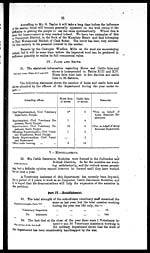Medicine - Veterinary > Civil Veterinary Departments > 1894-1932 - Annual report of the Punjab Veterinary College and of the Civil Veterinary Department, Punjab > 1909-1919 > 1918-1919 - Annual report on the Punjab Veterinary College, Civil Veterinary Department, Punjab, and the Government cattle farm, Hissar, for the year 1918-19
(480) Page 10
Download files
Individual page:
Thumbnail gallery: Grid view | List view

10
The mistake in the number of bulls of the Lahore District has been
rectified this time by including 112 bulls (that had been given to zamindars
on ½ price) in Column 6 of table VIII.
II.—EQUINES.
Number of stallions—Table X.
27. At the close of the year there were 67 horses and 74 donkey
stallions at work in the non-selected districts of
the province as compared with 61 horses and 69
donkeys, in the previous year.
To overcome the difficulty of obtaining suitable Arab stallions, breeding
of Arabs has already been started on the Government Cattle Farm, Hissar,
and it is hoped that in years to come the province will be self-supporting as
regards the supply of Arab Stallions for selected districts.
The following additions and casualties took place during the year :—
|
Increase. |
Horses. |
Donkeys. |
|
Purchased by District Boards |
6 |
2 |
|
Received from Civil Veterinary Department |
4 |
8 |
|
Total .. |
10 |
10 |
|
Decrease. |
|||
|
Died ... |
... ... |
2 |
3 |
|
Sold ... |
... ... |
2 |
2 |
|
Total |
4 |
5 |
|
Services of horse, pony and donkey
stallions—Table XI.
28. The total number of horse, pony and donkey stallions employed at
stud during the year was 4, 61 and 71. They
covered 199, 2,979 and 3,680 mares, respective-
ly. Last year 133,2,784 and 3,876 mares were covered by 4, 57 and 71 horse,
pony and donkey stallions respectively. The average number of mares covered
was 49 7, 48.83 and 51.83 per horse, pony and donkey stallion respectively
against 34.5, 48.84 and 54.59 in the preceding year. The new system of one
jump per mare has just been introduced which will enable stallions to cover a
large number of mares.
Feed and keep of stallions—Table XII.
29. The average cost of feed and keep, etc.,
of the stallions during the year under report
was—
Rs. 422 per horse, Rs. 486 per pony and Rs. 263 per donkey against Rs. 406 per
horse, Rs. 412 per pony and Rs. 223 per donkey in the previous year. These
figures are as usual supplied by the District Boards.
III.—SHEEP AND GOAT BREEDING.
30. During the year under report 105, ¾, and half bred merino rams
were sold from the Hissar Farm out of which only one was purchased by the
Jullundur District Board, and the remaining 104 were purchased by private
individuals of the following districts :—
|
1. |
Jullundur |
... ... ... |
... 1 |
|
2. |
Hissar |
... ... ... |
... 63 |
|
3. |
Ferozepore |
... ... ... |
... 40 |
The experiment of merino breeding in the Kangra District owing to the
lethargic nature of the gaddis and Kulu people was unsuccessful, hence the
flock of merinos at Palampur was transferred to Lahul where the crosses
between merino and the Lahuli and Biangi breeds have shown an improvement
in the wool.
Set display mode to: Large image | Zoom image | Transcription
Images and transcriptions on this page, including medium image downloads, may be used under the Creative Commons Attribution 4.0 International Licence unless otherwise stated. ![]()
| Permanent URL | https://digital.nls.uk/75532844 |
|---|
| Additional NLS resources: |
|---|




